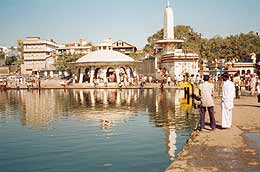|
Nasik is a town located 190 km northeast
from Bombay on the banks of Godavari river, which flows across middle
India to Bay of Bengal. It has approximately 800 000 inhabitants. This
place was called Padmanagar in Satya-yuga, Trikanta in Treta-yuga, Janasthana
in Dvapara-yuga and Nasik in Kali-yuga.
(by clicking on pictures
you will get three times bigger ones in new window)
 |
Sri Ramacandra lived in Nasik for some time during His exile.
Ravana also kidnapped Sita here.
Nasik got its name because Laksmana cut Surpanaka's nose here.
|
 |
Kumbha-mela is held here every 12 years.
Sri Chaitanya also visited Nasik on His travels around India.
|
 |
Ramakund is a water tank where Ramacandra and Sita took
bath. It is a main place of pilgrimage in Nasik. The bones dissolves
in this tank and until now the bones of important people of India
are thrown in this lake. Sri Ramacandra performed funeral rites
in memory of His father Dasaratha here. In recent history, the
bones of Mahatma Gandhi, Nehru, Indira Gandhi, Rajiv Gandhi, Rajendra
Prasad and other important personalities were dissolved in this
sacred lake.
|
 |
The temple of Sundara-Narayana
built in 1756 is interesting from architectonic point of view. Deities
of Laksmi and Vishnu are 90 cm tall. The temple is located on the
opposite side of the Godavari river. |
 |
Demigod Ganesh is known for creating and removing obstacles in
all spheres of activity. Srila Rupa Gosvami in Bhakti-rasamrita-sindhu
(the Nectar of Devotion) said that devotees should worship Ganapati
to help them remove obstacles on the path of devotional service
to Krishna.
Ganesh is usually worshipped at the beginning of different functions
and projects and he is kept as doorkeeper at entrances.
|
 |
He has one tusk only, because the other one was used for writing
the Vedas, dictated by Vyasadeva. In the other hand he can have
chopper symbolizing the cutting of illusion and falsities or a
rod symbolizing his emphasis for proper spiritual discipline or
noose for capturing wild animals representing lusty desires...
...or he can hold sweets for which he has genuine fondness.
|
|





